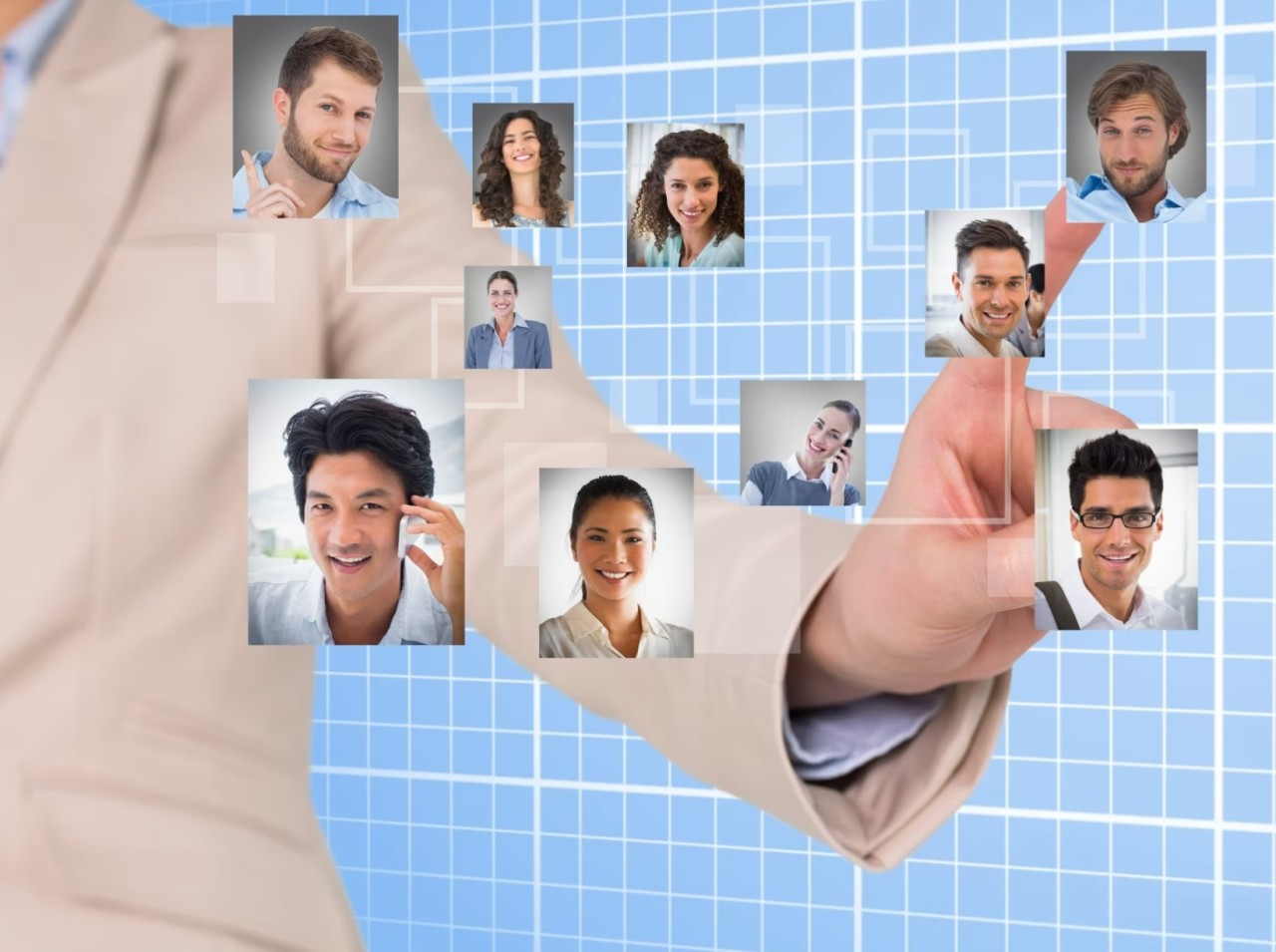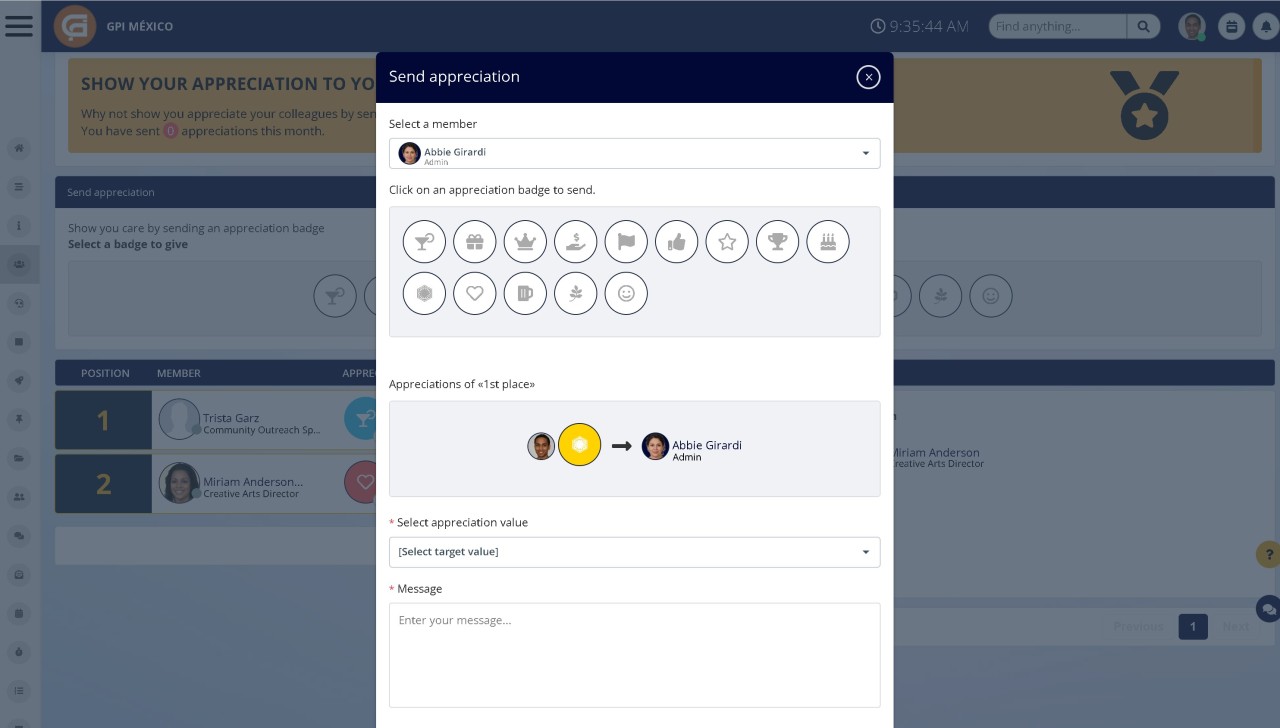Insight Blog
Agility’s perspectives on transforming the employee's experience throughout remote transformation using connected enterprise tools.
18 minutes reading time
(3630 words)
Employee Recognition Wall Ideas – UPDATE 2025 - A Complete Guide
Employee recognition can manifest in various ways, such as providing bonuses, offering verbal praise, or even writing a heartfelt thank-you note.
In today's workplace, the importance of employee recognition cannot be overstated.
This is particularly true in the context of remote working, as employees yearn to feel valued and appreciated. Failing to meet this need can result in employees quitting without any intention of returning.
A survey conducted by OnePoll on behalf of Bonusly revealed that nearly half of U.S. workers (46%) have left a job due to feeling unappreciated.
Additionally, 65% of respondents expressed their willingness to work harder if their contributions were acknowledged by management. However, it's not only recognition from managers that makes a difference.
The survey found that 65% of participants would be inclined to stay in a position with an unappreciative boss if their colleagues recognized and valued their work.
Employee recognition can manifest in various ways, such as providing bonuses, offering verbal praise, or even writing a heartfelt thank-you note.
Regardless of the specific method employed, the benefits of recognizing employees remain consistent for both the individuals and the organization as a whole.
Here are several reasons why employee recognition holds greater significance now than ever before.
The Importance of Employee Recognition in the Workplace
Employee recognition is a deliberate and continuous effort to express genuine appreciation for employees' contributions, achievements, and dedication. It extends beyond traditional rewards or recognition programs by fostering a culture of appreciation that inspires employees to perform consistently at their best. Recognition is not just a "nice-to-have"—it's a critical element for building a thriving workplace.
Studies reveal that employee recognition significantly impacts morale, productivity, and retention. According to a Gallup survey, employees who feel recognized are four times more likely to be engaged and 56% less likely to seek new job opportunities. Furthermore, a 2023 SHRM survey found that 89% of HR leaders believe recognition programs enhance the employee experience, leading to better overall performance.
A strong culture of appreciation creates a ripple effect. When employees feel valued, they are more motivated to deliver quality results, support their colleagues, and align with the company's mission and goals. Recognition also strengthens relationships between managers and employees, cultivating trust and mutual respect. This can be achieved through various forms of recognition, including verbal praise, team shout-outs, personalized rewards, or peer-to-peer acknowledgement.
However, the effectiveness of recognition lies in its consistency and authenticity. Employees can quickly spot insincerity or performative gestures. To avoid this, organizations must embed recognition into their daily operations and ensure managers are equipped with tools and training to provide meaningful and timely feedback.
As workplaces continue to evolve, prioritizing employee recognition is no longer optional. It is a strategic investment that enhances job satisfaction, improves retention rates, and boosts productivity. Creating a culture of appreciation is one of the most cost-effective ways to empower employees and drive business success.
Companies can foster a positive work environment that benefits everyone involved by valuing and recognizing employees regularly.
The Power of Employee Recognition
The power of employee recognition cannot be underestimated. In today's dynamic and competitive work environment, recognizing and appreciating employees has become crucial for organizational success. Here are several reasons why employee recognition holds such power:
When employees receive recognition for their hard work, it validates their efforts and provides a sense of achievement. This, in turn, ignites their motivation to perform at their best and strive for excellence.
Recognized employees feel valued and appreciated, which fuels their enthusiasm and dedication towards their work.
Engaged employees are more committed, proactive, and willing to go the extra mile to achieve organizational goals.
By recognizing their contributions, organizations create an emotional connection with their employees, fostering a sense of belonging and loyalty.
Engaged employees are more likely to stay with the company, reducing turnover rates and retaining top talent.
Employee recognition also has a positive impact on teamwork and collaboration. When individuals are recognized for their achievements, it not only boosts their confidence but also encourages them to share their knowledge and expertise with others.
Recognized employees become role models, inspiring their peers to perform at their best. This collaborative spirit enhances communication, cooperation, and synergy among team members, leading to improved productivity and efficiency.
When employees are acknowledged for their contributions, they are more inclined to seek new challenges, expand their skills, and pursue professional growth. Recognition creates a culture of learning and development, where employees are motivated to enhance their performance and contribute to the organization's success.
Importantly, employee recognition nurtures a positive work culture. A culture of recognition promotes trust, respect, and appreciation, fostering a supportive and inclusive environment.
When employees feel valued, they are more likely to express their ideas, engage in constructive dialogue, and contribute to innovation and creativity.
A positive work culture attracts and retains top talent, as it becomes a magnet for individuals seeking a fulfilling and rewarding workplace experience.
What is a Employee Recognition Wall
The concept of a "Wall of Recognition" involves a designated space where colleagues can express compliments and appreciation for one another, eliminating the barriers that often hinder the giving and receiving of compliments.
Cultural norms and individual preferences can make it challenging to offer compliments publicly.
Some cultures may find public compliments inappropriate, while in others, individuals may hesitate due to concerns about being misunderstood. It's important to note that these reservations do not indicate a lack of appreciation for kind words but rather stem from discomfort or uncertainty.
Some people struggle with receiving compliments and may respond by downplaying their achievements or expressing disbelief in their deservingness. Such reactions can make the compliment-giver feel uncomfortable, ultimately leading to a reduction in meaningful compliments exchanged.
It is essential to continue offering face-to-face compliments whenever possible, as they have the greatest impact.
However, the "Wall of Recognition" serves as a safe and comfortable environment that facilitates easy compliment-giving. By providing a designated space for compliments, it eliminates any discomfort associated with receiving or giving feedback.
This setup encourages individuals who may typically struggle with compliments to practice the art of providing positive feedback.
The outcomes of implementing a "Wall of Recognition" extend beyond a collection of compliments. We have observed several positive side effects, including enhanced collaboration, increased levels of trust and empathy, and improved work-life balance ratings.
Additionally, many of our employees have displayed the received compliments in their workspaces, inspiring others to engage in more compliment-giving.
This ripple effect, often referred to as the butterfly effect, is tangible and represents one of the most significant results. It generates a positive cultural shift that is invaluable.
By embracing the "Wall of Recognition" concept, organizations can foster a supportive and uplifting work culture.
It encourages the practice of expressing appreciation and cultivates an environment where compliments flow freely, ultimately leading to greater employee satisfaction and a more positive workplace.
Why You Need An Employee Recognition Board?
If you believe that your employees are only motivated by their paychecks and office perks like a ping pong table, think again. An increasing number of companies are prioritizing employee recognition and appropriate rewards as fundamental aspects of their business operations.
After all, where would you be without the individuals who dedicate their time and talent to achieve your business objectives?
Employee recognition and rewards should always be genuine, rather than mere ploys to boost short-term sales. Instead, recognition should be an ongoing practice.
By consistently acknowledging and rewarding hard work, you will experience more benefits beyond temporary spikes in productivity.
Let's examine how long-term and regular employee recognition contributes not only to the happiness of your employees but also to the success of your business.
Recognizing the hard work of your employees and providing them with appropriate rewards is crucial for both their personal satisfaction and the success of your business.
Here's why:
- Motivation and Increased Productivity: Recognizing and rewarding employees for their efforts serves as a powerful motivator. It fosters a sense of accomplishment and encourages teamwork, ultimately boosting productivity levels.
- Improved Workplace Culture: Implementing a culture of recognition creates a supportive work environment. Employees feel appreciated and valued, leading to higher job satisfaction and stronger camaraderie among colleagues.
- Talent Retention and Reduced Turnover: Recognizing and rewarding employees' contributions plays a significant role in retaining top talent. When individuals feel acknowledged for their hard work, they are more likely to stay committed to your organization, reducing turnover rates.
- Sense of Purpose and Values: Regular recognition instills a sense of purpose within employees. When their efforts are acknowledged, they understand the value their work brings to the organization, leading to increased dedication and alignment with the company's values.
We all have a basic human need to feel valued and appreciated, not only by friends and family but also by our colleagues. Receiving praise and recognition from peers and managers feels gratifying and enhances job satisfaction.
Work can be a source of fulfillment, and by providing recognition and rewards, you contribute to employees' happiness.
This happiness then translates into customer satisfaction, higher employee productivity, and numerous other positive outcomes.
However, it's important to ensure that recognition is done correctly. It doesn't mean you have to celebrate every small achievement with a cake or reward.
Recognition should be generously given, but also genuine.
Avoid giving rewards solely for the sake of social media posts, as it may have negative consequences in the long run.
How to increase Engagement levels
During my tenure at a company, we devised an innovative solution called the "Wall of Positivity" to address the need for improved feedback and recognition, as identified through our Engagement Survey scores.
Upon analyzing the survey results and reviewing employee comments, we discovered that many individuals felt their efforts were not adequately recognized, rather than solely seeking rewards or bonuses.
They expressed a genuine desire for more positive feedback and acknowledgment for their daily accomplishments.
While managers traditionally assume the responsibility of providing feedback, we recognized the evolving landscape of self-managing teams, where managers actively participate as team members. In such a context, we questioned whether positive feedback should solely originate from managers.
Consequently, we introduced the concept of the "Wall of Positivity." This initiative involved displaying a physical or virtual wall during various occasions such as large group meetings, smaller settings, or even Hackathons—whenever a gathering could benefit from a genuine positivity boost.
The wall served as a platform for colleagues to share uplifting messages, commendations, and expressions of appreciation for one another's work.
Since implementing the "Wall of Positivity," we have witnessed its effectiveness in fostering a more positive and encouraging work environment.
I strongly encourage you to consider adopting this practice within your own organization and observe the transformative impact it can have on employee morale and engagement.
Give the "Wall of Positivity" a try, and I am confident you will experience firsthand how it cultivates a culture of recognition and support.
11 Employee Recognition Wall Ideas
I want to make it clear from the start: There is no universally proven formula for a successful employee recognition program.
What may work effectively for one organization does not guarantee the same results for another. Even strategies that were successful for you just a couple of years ago may no longer be applicable in today's ever-changing workplace. The world is evolving, the job market is shifting, and naturally, employee expectations are evolving as well.
So, what does it take to discover the unique recipe for your own successful recognition program? We believe it requires persistence, a willingness to experiment, and a strong determination to succeed.
Here are a few ideas to to start with:
- Honor your team with year-end accolades - This celebration can take place at the company-wide, divisional, or team level, depending on the size of your organization. It requires some ingenuity and a deep understanding of your employees, but the investment is well worth it. Identify the individual who excels at meeting tight deadlines, deserving the "On the Dot" award. Who radiates positive energy? They would be the recipient of the "Mr. or Ms. Sunshine" award. Who else deserves recognition? Explore the possibilities.
- Initiate a Traveling Trophy initiative - Choose an amusing trophy or a cuddly stuffed animal that can circulate among the office. In remote work environments, this concept can be adapted into a special virtual background. Embrace something that brings smiles to your team members' faces. Consider introducing awards like the "Top Banana" or the "Unicorn of the Week." Present the award to an employee who exceeded expectations and let them proudly display it on their desk for a week or use it as their virtual background during the next team meeting.
- Acknowledge your top appreciators - Whenever an employee recognizes a colleague, put their name in a hat, whether it's physical or virtual. At the end of the week or month, randomly draw a few names from the hat and treat those employees to a company-sponsored meal.
- Embrace the power of social media - In today's job market, potential candidates utilize social platforms to research job opportunities, presenting employers with excellent prospects. Showcase your employees on your corporate social media channels by posting photos capturing moments of public recognition and sharing statistics related to your rewards and recognition program. Utilize relevant hashtags like #recognitionawards and #employeeappreciation.
- Prioritize learning and growth - Does your recognition program encompass educational opportunities such as conference attendance, training sessions, and coaching? Highlight the importance of continuous learning and development to attract top talent, emphasizing that your organization values employee growth.
- Feature every employee on your "About Us" page. - Who says only the leadership team should be showcased on the company website? Instead, recognize each and every member of your workforce. Demonstrate your pride in your team and provide potential employees with the chance to see the individuals they will be working with.
- Early recognition makes a difference - Have you ever considered sending a personalized gift to a standout candidate as part of their job offer? This gesture can transform your offer into a special moment, not only delighting new hires but also encouraging them to spread the word about their positive experience. It's never too early to start recognizing and appreciating the talent you're bringing on board.
- Embrace the joy of everyday victories! - Kickstart each team meeting by highlighting recent wins, fostering a culture of recognition within your business. Discuss the progress you and your team have made on projects, celebrate small triumphs, and encourage everyone to acknowledge and appreciate the support and assistance of their colleagues.
- Promote well-being initiatives - Encourage healthy behaviors that contribute to a thriving workplace, whether it's organizing a company step challenge or offering flu shots. Create nutrition challenges and reward employees for taking steps towards adopting healthier habits.
- Delight your team with food - While many aspects of corporate recognition programs focus on celebrating achievements, it's equally important to recognize the value of each and every team member. Arrange periodic or surprise team lunches as a way to demonstrate this appreciation. Even remote or hybrid workers can be included in these team lunches with proper organization and coordination.
- Gamify peer-to-peer recognition - Not everyone excels at expressing appreciation through words alone, but with the right tools, your employees are more likely to engage in regular peer-to-peer recognition. Explore AgilityPortal appreciation tool, designed to make it effortless to spread positive vibes by simply filling out a few fields.
Recognition Board Ideas For Digital Workspaces
- Virtual Shoutouts - Create a dedicated channel or board where team members can publicly recognize and appreciate their colleagues' achievements. Encourage everyone to share a shoutout for a job well done, a valuable contribution, or a display of teamwork. This allows for visible recognition and boosts morale in the digital workspace.
- Achievements and Milestones - Set up a recognition board to celebrate significant accomplishments and milestones achieved by team members. Whether it's completing a challenging project, reaching a target, or earning a certification, highlight these achievements on the board to inspire and motivate others.
- Gratitude Wall -Establish a space where team members can express gratitude and appreciation for the support they receive from their peers. Encourage them to post messages, testimonials, or specific instances where someone's assistance made a difference. To make this space even more inspiring, consider decorating it with Framed Canvas Picture Prints for Wall Art, creating a visually uplifting atmosphere that reflects the team's positivity and collaboration. This fosters a positive and supportive work environment, even in a digital setting.
- Innovation Corner - Dedicate a section of the recognition board to showcase innovative ideas, creative solutions, or process improvements initiated by team members. This highlights their contributions to the team's growth and success, and encourages a culture of innovation and continuous improvement.
- Spotlight on Learning - Create a dedicated space to recognize team members' dedication to personal and professional development. Highlight achievements such as completing courses, attending webinars, or acquiring new skills. By sharing these milestones, you foster a culture of continuous learning and inspire others to embark on their own growth journeys.To make this recognition space truly special, consider using custom canvas photo prints for wall art. Feature photos of team members alongside their accomplishments, transforming the area into a visually engaging tribute to growth and success. These personalized prints not only add a unique touch but also serve as a constant reminder of the value your organization places on development and progress.Celebrating achievements in such a creative way motivates individuals and reinforces the importance of lifelong learning in your workplace.
Remember to adapt these ideas to suit your specific digital workspace and utilize appropriate digital tools and platforms to implement them effectively.
Understanding The Power of Recognition
Recognition is a powerful force that has the ability to shape and transform individuals and organizations. It is a fundamental human need to be seen, acknowledged, and appreciated for one's contributions and achievements.
The power of recognition lies in its ability to validate and motivate individuals, foster a positive and inclusive work culture, and drive performance and productivity.
When individuals receive recognition for their efforts, it validates their hard work and achievements. It communicates to them that their contributions are valued and that they are making a meaningful impact.
This validation boosts their self-esteem and confidence, leading to increased job satisfaction and a sense of fulfillment. Recognized individuals are more likely to be motivated and engaged, striving to continue performing at a high level and surpassing expectations.
Recognition also plays a crucial role in fostering a positive and inclusive work culture. When people are recognized and appreciated, it creates a supportive environment where individuals feel valued and respected.
This, in turn, strengthens team morale and collaboration, as people are more inclined to support and celebrate each other's successes.
A culture of recognition encourages a sense of belonging and loyalty among employees, leading to higher retention rates and reduced turnover.
This is completely powerful tool in the workplace.
Engaging Employee Participation
Engaging employee participation is crucial for fostering a motivated and productive workforce.
When employees are actively involved and invested in their work, they are more likely to contribute their best efforts and feel a sense of fulfillment.
Here are some strategies to promote and enhance employee participation:
- Open and Transparent Communication - Establish a culture of open communication where employees feel comfortable sharing their ideas, concerns, and suggestions. Encourage regular feedback from employees and ensure that their voices are heard and valued. Provide platforms for employees to express their opinions, such as team meetings, suggestion boxes, or digital collaboration tools.
- Clearly Define Roles and Responsibilities - Clearly communicate the roles, responsibilities, and expectations of each employee. When employees have a clear understanding of their roles and how they contribute to the overall goals of the organization, they are more likely to feel engaged and motivated.
- Encourage Collaboration and Teamwork - Foster a collaborative work environment where employees are encouraged to work together, share knowledge, and support each other. Promote cross-functional projects and team-building activities that facilitate collaboration and build strong working relationships.
- Provide Opportunities for Growth and Development - Offer employees opportunities for learning and professional development. This can include training programs, workshops, mentorship, or tuition reimbursement. By investing in their growth, employees feel valued and motivated to actively participate and contribute to their fullest potential.
- Recognize and Reward Employee Contributions - Implement a comprehensive employee recognition program that acknowledges and rewards exceptional performance and achievements. This can be in the form of verbal praise, written appreciation, or tangible rewards such as bonuses or incentives. Recognizing employees' efforts and contributions boosts morale and encourages continued active participation.
- Empower Employees - Delegate authority and decision-making power to employees whenever possible. Empowered employees feel a sense of ownership and responsibility for their work, leading to increased engagement and participation. Encourage employees to take initiative, contribute ideas, and be involved in decision-making processes.
- Foster a Positive Work Culture - Create a positive work environment that promotes trust, respect, and inclusivity. Encourage work-life balance, provide support for employee well-being, and celebrate achievements and milestones. A positive work culture cultivates employee loyalty and commitment, driving active participation.
Remember that engaging employee participation is an ongoing process that requires continuous effort and commitment from both management and employees.
By implementing these strategies, organizations can create an environment where employees feel motivated, valued, and actively involved in their work.
Categories
Blog
(2600)
Business Management
(319)
Employee Engagement
(207)
Digital Transformation
(173)
Intranets
(119)
Growth
(118)
Remote Work
(61)
Sales
(48)
Collaboration
(37)
Culture
(29)
Project management
(29)
Customer Experience
(26)
Knowledge Management
(21)
Leadership
(20)
Comparisons
(5)
Ready to learn more? 👍
One platform to optimize, manage and track all of your teams. Your new digital workplace is a click away. 🚀
Free for 14 days, no credit card required.

















